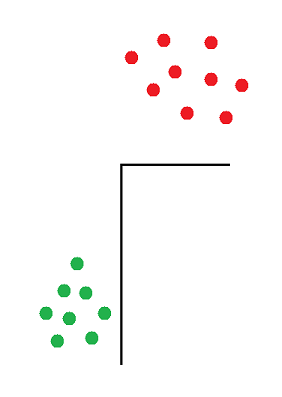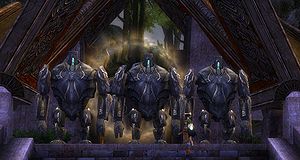Body block
| This article needs to be cleaned up, see Guild Wars Wiki:Formatting for details. |
Foes and allies alike are physical presences on the battlefield — one cannot simply walk through another character. Players can therefore use their characters' bodies to block or slow the movement of another character. This is known as body blocking, a particular kind of snare that can be performed by any character.
Pets, minions, spirits, and NPCs have the same physical presence as other characters and so can participate in body blocking.
In outposts and PvE areas, friendly characters can be moved through without restriction (excluding some NPC allies that spawn due to a mission or quest, e.g. Kormir in Abaddon's Gate); however, in PvP matches, friendly characters (including pets and minions) can body block each other. For example, two warriors both chasing the same kiting opponent might body block each other -- allowing the target to escape with less damage. Keep in mind, your teammates have smaller bounding boxes than your opponents. This can enable your teammates to go through some body blocks, while the enemy can not. When this occurs, it can be best for one of the warriors to either break off and attack another target -- or position himself to approach the original target from a different angle.
The Master of Blocking on the Isle of the Nameless provides players with a short tutorial on body blocking. The skill can also be practiced in skirmish.
Techniques for successful body blocking[edit]
- If one of your teammates is kiting from a melee train, or running a relic, then you can easily position yourself just behind your teammate and, if done right, you will stop the enemies movement for a few seconds.
- For easier/better body blocking you can try and guide an enemy toward a wall or narrow passage, this way you need fewer players to body block.
- Most maps only require two players to body block a narrow passageway.
- In the open areas you need as little as three players to stop someone, each one lined up at the vertices of an equilateral triangle.
- Use snares or knock downs to stall a target until your team can surround it.
Applications by game type[edit]
Guild Battles[edit]
- Body blocking an enemy's Flag Runner can allow your team to receive a Morale Boost, or at very least, allow your team to get an advantage in terms of Flag Running, and thus more time to overwhelm the opposition with your Flag Runner present.
- Blocking the Resurrection Shrine of an enemy team with downed members at the moment of their resurrection may catch newly resurrected players unprepared and far away from their monks and provide your team with easy kills. Keep in mind there is a 5 second time buffer in which your spells/attacks do not affect the newly resurrected players.
- Recently killed soft targets corpses can be surrounded to discourage resurrection or easily apply pressure once it is resurrected.
- On some maps, (best example being the Vine Bridge on Druid's Isle), narrow paths or doorways can be blocked while your team assaults the enemy base or their Guild Lord. The body blocking delays or prevents the enemy monks from reaching whatever needs to be healed. This same strategy can be used to place a barrier between your soft teammates, and their damage dealers.
- On maps with catapults, you can body block the front door, trapping fleeing enemies or NPCs in the courtyard allowing them to be prime targets for the catapults. Remember to apply protection skills as the catapults are known to be able to reach those in the doors.
- Placing your character between a fleeing enemy and his destination will have a snaring effect as the character will have to path around yours, thus taking longer to reach his destination.
Heroes' Ascent[edit]
- Body blocking can slow or prevent a relic runner from scoring points.
- Body blocking an opposing Ghostly Hero can stop him from reaching the capture point in King of the Hill maps.
PvE[edit]
- Body blocking can be used to trap groups of enemies in a small area, rendering them vulnerable to AoE and keeping melee foes from reaching more fragile characters. Ranged foes that require line-of-sight to attack can be trapped against obstructions to block their attacks on fragile party members.
- It is possible for one player to perform such body blocks by luring enemies to themselves and running up against a wall/corner. Once the enemies have been gathered the blocker can then take a single step away from the wall to obstruct the path they will take when they attempt to scatter from certain skills.
- Melee enemies will attempt to surround a player and form a body block when initially engaging. This can be avoided by strafing as they converge, causing them to miss their opportunity and all end up to the sides and behind the player.
Tactics to note[edit]
While trapped in a bodyblock, several enemies will surround one target; this will leave them open to AoE attacks and spells. If a Dervish is trapped they can use their scythe and point blank area of effect skills to break a block. Elementalist AoE skills from the Fire and Earth lines and AoE Smiting skills from the monks can also be used to punish the body blocking players and break the block through heavy damage.
Area of effect snares, such as those in the Elementalist Water Magic line, or Shared Burden from the Mesmer line work well to break incomplete blocks by stopping the blockers from moving into the path of the block target.
Minions and Pets can be used to body block, although whether they do or not is largely a matter of luck. They can also block both enemies and allies which makes them more unreliable than other blocking techniques.
Strategic placements of Ritual spirits can be used by Ritualists and Rangers to set up blocks which do not require any other allies to maintain.
Both Warriors and Rangers, due to their high armor and/or defensive stances, are best able to maintain a block on a character as they can stand up to the damage from the opposition trying to break the block. They're also more likely to survive being blocked for the same reasons.
Caster classes can also participate successfully in blocking, especially if the opponents do not have AoE skills to punish blockers. When not positioning themselves defensively or kiting, a caster can position themselves to disrupt melee trains on others, slow flag runners, or prevent overextended attackers from returning to healing range.
Notes[edit]
- Guild Wars has no Z-axis, so body blocking is possible regardless of vertical positioning.
- Some NPCs use this tactic to form a protective semi-circle around their monk, specifically, Charr warbands in Eye of the North and Luxon parties inside the Echovald Forest.

